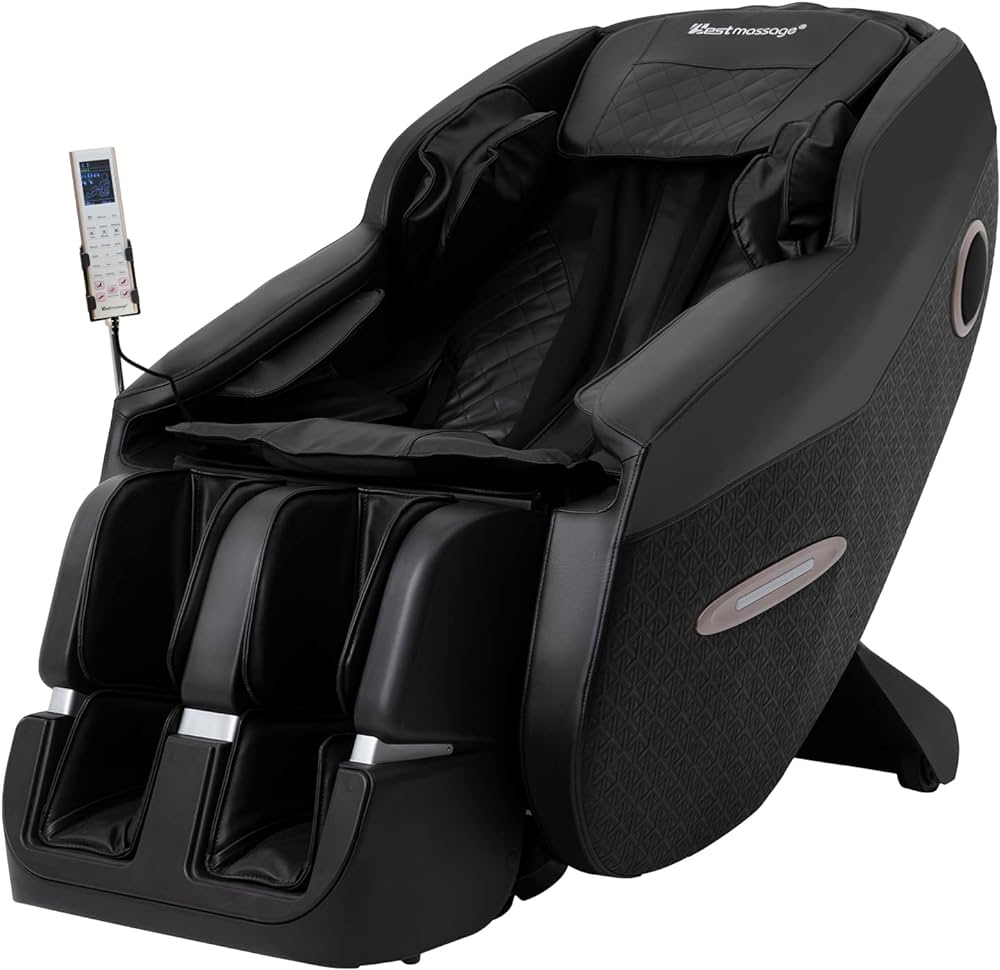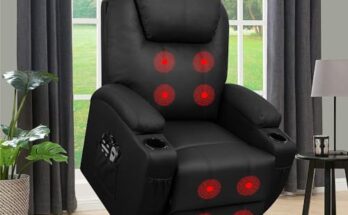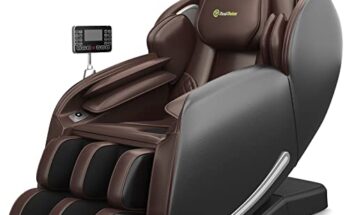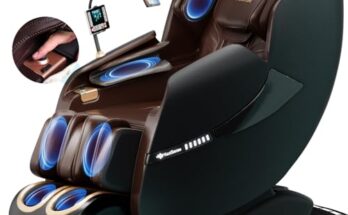A massage chair may be costly and take up significant space. It may also fall short for those needing personalized massage therapy.
Massage chairs have increasingly become a popular home accessory for individuals seeking relaxation and muscle relief. Despite their convenience and advanced features, these modern wonders aren’t without their drawbacks. Massage chairs represent a substantial financial investment, often costing thousands of dollars, which might not be feasible for everyone’s budget.
Occupying a considerable amount of room, they are not ideal for smaller living spaces where every inch counts. While technology has come a long way, a massage chair can’t fully replicate the nuanced techniques of a professional massage therapist, potentially limiting the therapeutic benefits for users with specific medical conditions or preferences in massage style. Users should weigh these factors against the potential benefits to make an informed decision about incorporating a massage chair into their wellness routine.
The Cost Factor
Many consider massage chairs a relaxing escape from daily stress. Yet, it’s crucial to discuss the financial side. Massage chairs often carry a hefty price tag, not just at purchase but in the long run too.
Optional Table to summarize the cost| Cost Type | Typical Range |
|---|---|
| Initial Investment | $500 – $10,000+ |
| Maintenance Expenses | Varies with usage |
Initial Investment
Buying a massage chair often means a significant upfront cost. Prices range from a few hundred to several thousand dollars. The variety, features, and brand influence the investment. Here’s what affects prices:
- Brand reputation and quality.
- Number and type of features.
- Type of massage technology.
- Materials and durability.
Maintenance Expenses
After purchase, your chair will need regular upkeep. This includes
- Cleaning and treating the upholstery.
- Electricity for operation.
- Occasional repairs or part replacements.
These expenses add up over time. Some chairs have self-diagnostic features to alert you to problems. This can save on maintenance costs but often comes with higher initial prices.
Keep these costs in mind before investing in a massage chair. A well-informed choice ensures that you enjoy the experience without unwelcome surprises.

Credit: www.massage-chair-relief.com
One Size Does Not Fit All
‘One Size Does Not Fit All’ is a truth for many products, and massage chairs are no exception. While they offer the promise of relaxation and relief, it’s essential to understand that they may not cater to every individual’s unique body shape and size. In our quest for relaxation, let’s delve into the challenges this “one-size-fits-all” approach can bring to potential massage chair owners.
Limited Customization Options
Massage chairs come with preset programs designed to cater to a wide audience. Yet, this generalized design means they might not address specific needs or preferences. Consider the body: everyone’s physique is different. Some users may find that the massage nodes don’t quite hit the right spots, or the intensity settings can’t be finely tuned to their liking.
- Set massage programs may not suit all
- Lack of fine-tuning for personal preferences
- Varying user heights and weights might not be fully accommodated
Potential Discomfort For Some Users
Not every user will find a massage chair comfortable. Discomfort can arise if the chair cannot adjust to various body types. For instance, taller individuals may find that the chair is too small, while shorter users might struggle to reach the footrest. Moreover, the firmness of the massage can be a reason for discomfort, with some finding it too gentle and others too intense.
| User Concern | Issue |
|---|---|
| Height | Too high or too low seating arrangements |
| Footrest | Non-adjustable, causes discomfort |
| Massage Intensity | Might be too strong or too weak |
Physical Space And Aesthetics
The topic of Physical Space and Aesthetics may not spring to mind when picturing the bliss of a massage chair. Yet, these factors hold significant sway in your purchase decision. Let’s explore the often-overlooked drawbacks of owning these modern thrones of relaxation—their imposing size and the challenge of blending them into your home decor.
Bulky Dimensions
Massage chairs are known for their generous proportions. A substantial footprint is necessary to house the mechanics that deliver those delightful kneads and taps.
- Space Requirement: A massage chair can dominate a small room or apartment.
- Maneuverability: Moving it around can be a challenge due to its hefty build.
- Doorway Issues: Fitting one through doors can be like threading a needle with a rope.
Interior Design Considerations
Integrating a massage chair into your living space is not always smooth sailing. It can feel like putting a spaceship in a Victorian living room.
| Challenge | Details |
|---|---|
| Style Mismatch | They often come in modern or future-forward styles that may clash with classic interiors. |
| Domination | The chair may become the unintended focal point of a room. |
| Color Palette | Options are limited, possibly leading to color scheme compromise. |
In sum, a massage chair requires both space and a design strategy. Be ready to creatively blend form with function to enjoy its benefits without regret.
Credit: www.quora.com
Dependency And Overuse Concerns
Many users find massage chairs an excellent way to relax. Yet, while they offer convenience, concerns arise with dependency and overuse. This downside is often overlooked in the quest for quick relief.
Risk Of Habituation
Getting too comfortable with a massage chair can lead to habituation. Users may find that the more they use the chair, the more they feel they need it. This can become an issue, especially if the chair becomes a crutch for relaxation or pain relief.
Possible Side Effects From Excessive Use
It’s important to moderate the use of any therapeutic device, including massage chairs. Overuse can lead to side effects, such as:
- Muscle soreness
- Increased inflammation
- Numbness or tingling
- Pain instead of relief
Exceeding recommended durations or frequencies of massage sessions can backfire. It may lead to discomfort or even minor injuries. Users should heed manufacturer guidelines and listen to their bodies to avoid these risks.
Electrical And Technical Issues
Modern massage chairs offer relaxation at the touch of a button. But, like all technology, they come with their own set of problems. Electrical and technical issues are common with massage chairs. These issues can disturb your peaceful experience. Let’s explore some problems you might face.
Power Consumption
Massage chairs use quite a bit of electricity. They need power to run motors, heat elements, and control systems. Your electricity bill may go up. Here are some points about their power usage:
- High-end chairs need more energy.
- Average chairs consume between 150 to 300 watts.
- Using your chair often will increase your energy costs.
Malfunctions And Repairs
Massage chairs can break down. Fixing them is not always easy. Look below for common issues:
| Malfunction Type | Common Causes | Impact |
|---|---|---|
| Software glitches | Update errors, bugs | Chair stops working correctly. |
| Hardware failures | Worn out parts, overheating | Parts need replacing. |
| Electrical faults | Loose wires, power surges | May cause chair to shut down. |
Finding parts for repairs can be hard. Sometimes, only the company that made your chair will have parts. If your warranty has expired, repair costs can be high.

Credit: www.amazon.com
Health Precautions And Limitations
Massage chairs offer comfort and relief but not for everyone. It’s vital to know that these chairs have health precautions and limitations. Not everyone can sit back in a massage chair without potential risks. Let’s explore these close attention factors.
Contraindications For Certain Conditions
Important: Massage chairs are not safe for all health conditions. People with certain medical issues should avoid using them.
- Pregnant: Women expecting a baby should opt-out. An intense massage could pose risks.
- Heart Conditions: Those with heart problems must consult a doctor before use.
- Recent Surgery: Healing bodies need rest. A massage chair might disrupt this process.
- Severe Osteoporosis: Fragile bones can worsen with the force of a massage chair.
- Blood Clots: Vigorous massage action might dislodge blood clots, which is dangerous.
Substitution For Professional Therapy
Critical Reminder: Massage chairs should not replace professional therapy. They might offer quick relief, but they are not a substitute for tailored, professional care.
| Massage Chair | Professional Therapy |
|---|---|
| Generalized approach | Customized treatment |
| Limited techniques | Wide range of methods |
| No personal assessment | Detailed health evaluation |
| Can be overused | Monitored session lengths |
Remember, a massage technician will provide expertise that a machinery cannot. They assess and adapt to specific needs and conditions.
Frequently Asked Questions For What Are The Disadvantages Of A Massage Chair
Is There Any Side Effect Of Massage Chair?
Massage chairs may lead to minor side effects such as discomfort, headaches, or muscle aches. Overuse can exacerbate existing injuries or cause muscle soreness. It’s important to follow proper guidelines and use in moderation. Consulting with a healthcare provider is advisable for pre-existing conditions.
Who Should Not Use A Massage Chair?
People with certain conditions should avoid using massage chairs. These individuals typically include pregnant women, those with osteoporosis, blood clot risks, or heart conditions, as well as anyone with fractures or severe thrombocytopenia. Always consult a doctor before use.
How Long Should You Sit In A Massage Chair?
A typical session in a massage chair should last about 15 to 20 minutes. Avoid exceeding 30 minutes to prevent muscle soreness or overstimulation.
What Do Doctors Say About Massage Chairs?
Doctors often recognize massage chairs as beneficial for reducing stress, improving circulation, and relieving muscle tension. They may suggest these chairs as part of a comprehensive wellness routine.
Conclusion
Wrapping up, while massage chairs offer relaxation and convenience, they’re not without drawbacks. High costs, maintenance concerns, and the potential lack of customization options underscore the need for careful consideration. Always assess your wellness goals and research thoroughly before investing in a massage chair.
Choose wisely to ensure the benefits outweigh any disadvantages.



